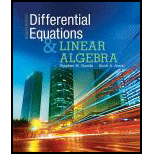
Concept explainers
For Problems
Whether
Answer to Problem 1AP
Solution:
The point
valid on
Explanation of Solution
Given:
The differential equation is,
Approach:
The point
Suppose their power series expansions are valid for
The ratio test is,
and if
Calculation:
The point
In the given equation
Let the general solution of the differential equation is
Differentiate equation
Substitute
Replace
Separate out the terms corresponding to
For
Thus,
Use this relation to determine the appropriate values of the coefficients.
Substitute successively for
When
When
When
When
When
Continue further to obtain
and
Use equations
Substitute
Now, substitute
For checking the solution is valid or not using the ratio test on both foregoing solution
Suppose,
Then by ratio test,
And if
So,
From above
Similarly for
Solve the above equations.
From above
Therefore, both series are convergent and the solution are valid on
Conclusion:
Hence, the point
valid on
Want to see more full solutions like this?
Chapter 11 Solutions
Differential Equations and Linear Algebra (4th Edition)
 Algebra and Trigonometry (6th Edition)AlgebraISBN:9780134463216Author:Robert F. BlitzerPublisher:PEARSON
Algebra and Trigonometry (6th Edition)AlgebraISBN:9780134463216Author:Robert F. BlitzerPublisher:PEARSON Contemporary Abstract AlgebraAlgebraISBN:9781305657960Author:Joseph GallianPublisher:Cengage Learning
Contemporary Abstract AlgebraAlgebraISBN:9781305657960Author:Joseph GallianPublisher:Cengage Learning Linear Algebra: A Modern IntroductionAlgebraISBN:9781285463247Author:David PoolePublisher:Cengage Learning
Linear Algebra: A Modern IntroductionAlgebraISBN:9781285463247Author:David PoolePublisher:Cengage Learning Algebra And Trigonometry (11th Edition)AlgebraISBN:9780135163078Author:Michael SullivanPublisher:PEARSON
Algebra And Trigonometry (11th Edition)AlgebraISBN:9780135163078Author:Michael SullivanPublisher:PEARSON Introduction to Linear Algebra, Fifth EditionAlgebraISBN:9780980232776Author:Gilbert StrangPublisher:Wellesley-Cambridge Press
Introduction to Linear Algebra, Fifth EditionAlgebraISBN:9780980232776Author:Gilbert StrangPublisher:Wellesley-Cambridge Press College Algebra (Collegiate Math)AlgebraISBN:9780077836344Author:Julie Miller, Donna GerkenPublisher:McGraw-Hill Education
College Algebra (Collegiate Math)AlgebraISBN:9780077836344Author:Julie Miller, Donna GerkenPublisher:McGraw-Hill Education





